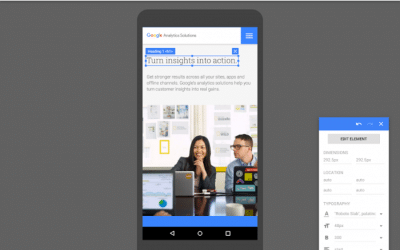How to offer the best ecommerce customer experience

By Ben Robson
Co-founder, GOAT
To prosper in a complex, competitive and fast paced market, retailers must deliver a superior and fulfilling customer experience, consistently and seamlessly across all marketing channels. It is a monumental challenge but one that retailers, big and small, need to overcome and marketers, at all levels, need to grasp if they are to win new customers and build valuable, long-term relationships with them.
The choice of e-commerce platform can have a major impact on a retailer’s ability to deliver this experience. The right features and functionality can greatly aid the likelihood of succeeding at each stage of the buying journey, beginning with visibility of the site in search engines (thereby acquiring targeted traffic), helping to convert that traffic and then retaining new customers through a good post purchase experience.
1. Research and consideration
For your site to reach and acquire customers during their research phase, it needs to be found across search engines – that’s pretty much a given. But once they arrive at your site it must also present prospects with access to as much information as possible to evaluate your products sufficiently. With this in mind, let’s take a look at a number of e-commerce features that are essential to meeting this goal:
Categorising products
The ability to categorise products will aid natural search visibility, as well as improve usability. Features associated with product categorising might include:
- Unlimited products and categories – Surprising as it might sound, some platforms have a limit to the number of products and categories you can create. Ensure you choose a platform that allows unlimited products and categories
- Product option selection – A product should be able to have unlimited options such as size, colour, etc. rather than having to create new product pages for each variation
- Grouped product view – Allows products to be grouped together. This works well if you are presenting a number of different products into collections or ranges
- Faceted navigation for filtering of products – It should be easy to add new filters and tag products. Filtering should also be search engine friendly i.e. it should create ‘friendly’ URLs and use keyword insertion in page titles, meta descriptions and h1 headers. The Marks and Spencer site is a good example of clear and comprehensive faceted navigation:
Product detail
By creating content over and above that of simple product descriptions, you are creating a more memorable experience should encourage a prospect to return to the site oe perhaps share that content even if they are not quite ready to commit to the purchase at this stage. Content might include:
- Product reviews – Usually a score out of 5, the ability to display average customer ratings for a product can help make your site a destination at the consideration stage but also help be a decision trigger
- Question and Answers – A Q&A sections take FAQs a step further by allowing customers to ask product specific questions. This level of interaction can significantly increase conversion rates as any doubts the customer has about a product can be dispelled
- User Generated Content (UGC) – Allow people not only to review but upload photos and videos of their experiences in using products. In turn, this helps prospects see products in their real world setting used by actual customers
- Product comparisons – Where products are complex, the ability to compare side by side is a very powerful feature to aid decision making. Wiggle.c.o.uk uses both a Q&A areas and reviews across their products with many of the customer reviews including images as well
Site search
Configurable search with auto-suggested terms. Many e-commerce systems fall down here. Users expect the search function to be as good as that of Google.
Showroom pages
More often than not, store pages are dull, un-engaging and lack personality. An e-commerce platform with advanced multichannel availability and logistic capabilities can significantly help with a smooth in-store/online purchase path.
- Store-specific content – Imagery, events, offers, staff biographies and the store manager’s ‘favourite product of the week’ are all methods by which to add relevant content to the page
- Store locator/search – Provide advanced search and filtering functionality, as well as a reliable mapping tool and directions
- Click and collect – The ability for a customer to select their local store and collect their order is a growing expectation of savvy customers. Obviously, the business needs to support this logistically before offering the service on the site!
- Save a store preference – Associate a store with a customer’s account to quickly allow the customer to look at stock availability locally to them
Although not injecting much personality, Mothercare.com do a good job with their store pages in terms of information. By capturing postcode searches from people looking for their nearest store, they can potentially start to join the dots between online and offline.

Ensuring the e-commerce platform is not going to cause any headaches for search engines will give your business the best possible foundation for natural search visibility.
- URL rewrites – Rewriting URLs in a friendly format, using words and not parameters is better for both the user and the search engines
- HTML mark-up – Marking up HTML using Schema.org can result in rich snippets in search results and improve click through rates
- Sitemaps – Both XML and HTML sitemaps should be generated and auto update
- Shopping feed creation – Important for Google AdWords Shopping campaigns as well as shopping comparison engines, the ability to generate comprehensive feeds that auto update but can also be customised to add or change product attributes
- Meta-information – It should be possible to specify page titles and meta descriptions for products and categories both template driven and specified by page
- Duplicate content prevention – Advanced canonical functionality across the site can help prevent duplication of products if placed in different categories and also help pagination issues
2. Ready to purchase
By removing barriers to conversion, an e-commerce platform can have a big impact on making the purchase process as easy as possible.
Design
Although not necessarily dictated by the e-commerce platform, the design and layout of the site should be customisable to an extent, ideally without the need for development resource.
- Category product layout – Product listings in grid or list format should be an option available to the customer and remembered for that user
- Flexible module based design – The ability to move certain pieces of content from one area of the page to another, whilst adding and removing landing pages will greatly increase your chance of being able to improve conversion rates through a/b testing, for example
- Flexible templates – Ability to assign designs on category and product level (unique design per product/category)
- Hero & header images – Carousels and image headers should be specifiable for the homepage, categories and across other areas of the site. JohnLewis.com make excellent use of hero & header images across their categories, highlighting latest ranges and deals.
Product detail
A customer needs to feel as informed as possible about a product before committing to purchase. The layout and information provided at a product level can have a big impact on this.
- Multiple images per product – Customers expect to see a large number of high quality product images
- Product image zoom-in capability – Images should be high resolution, be ‘zoom-able’ (did I just make that word up?!) by click and through movement of the mouse across the image
- Product image 360 degree view – Functionality to allow for products to be viewed from all angles
- Product coverage – Where products appear in publications, the ability to highlight this to the customer through thumbnail images/logos
- Product stock level tracking and notification – Ensure stock availability is visible and ideally in real-time to to avoid fulfilment frustration. Made.com make great use of product imagery, offering a number of images from different angles and showing the items in use and on their own.
Checkout
A smooth buying process from basket to checkout to completion will help minimise the customer ‘dropping off’ at any of these stages:
- Customisable checkout – A flexible checkout is important as this allows for testing, removing and reposition of form fields and so on
- Checkout without account/guest checkout – Probably the biggest mistake made by retailers (and the biggest bugbear for customers) is insisting an account is created in order to make the purchase. Don’t force this on customers up-front, offer it as an option after the sale with an incentive for doing so i.e. money off a next purchase
- SSL security support – Both front-end and back-end, secure checkout is vital for customers trust to complete the sale
- Saved shopping baskets – Ideally with configurable expiry time. Remembering a user’s product choices will avoid frustration if they accidentally close their browser or press the back button
Delivery
A key factor to conversion is an excellent shipping and delivery process. To achieve this, the e-commerce platform should be highly configurable to allow a multitude of flexible options (assuming the retailer has the processes and systems in place to offer these options of course):
- Trackable delivery – Customers expect to be kept up-to-date in terms of where their purchase is in transit or be able to find information on the status of their order on the site
- Configurable delivery cost – Free delivery or flat rate delivery per order or item from our experience are the best aids to high conversion rates. Clear information for differing weights, destinations etc, are also essential so all costs are clear up-front
- Print invoices and packaging lists from the order screen – Key to offering a smooth and efficient delivery service is to make the background processes simple and automated
Payment
A comprehensive range of payment features will allow customers to transact easily and conveniently.
- Payment gateway integration – Offering a broad range of payment gateways will ensure any obstacles to completion are minimised
- Discounts codes – The ability to add voucher/discount code at basket/checkout
- Credit card details – Securely remember users credit card details (should they wish to) saves time and effort next time they make a purchase
Active selling & dynamic merchandising
This refers to the art of cross-selling a similar or complimentary product to the one a customer has chosen to purchase. This is could be an alternative (before they have added to basket), an item that would complement their purchase or an additional item required for the chosen product to function properly.
- Recently viewed/compared products – The option to include a list of recently viewed products
- Active selling – The ability to push items through daily deals and new item promotions
- Configurable cross-sells, bundled items, up-sells and related items – All should be customisable, and be able to be added to different areas/templates of the site
- Wish lists – The ability to add desired products into a list associated with users account
IKEA make nice use of tabs to include an array of cross selling opportunity, matching and complementary products, similar items and more products from the same range:
3. Post purchase
Delivering on your promises after the purchase is essential to building trust and brand loyalty. An e-commerce platform can aid this in the following ways:
- Customer accounts – Allow customers the option to create an account that remember key details such as address and payment methods
- Customer service – Allows customers to make enquiries via their account and linked to the products they have purchased previously
- Online chat – Integration into the platform for customer service queries, as well as asking product specific questions
- Email marketing – Email marketing fully integrated with the customer database can feed into the retailer’s eCRM program
Conclusion
Whether off the shelf or bespoke, there is a lot to consider in terms of functionality when selecting an e-commerce platform. The above attempts to cover some of the key e-commerce features to ensure your site achieves its true potential and most importantly you deliver the kind of pre- and post-purchase experience needed to win in complex and competitive sectors, such as homewares and fashion.
Keep reading?
The six principles of influence in web design
Discover how The Psychology of Persuasion can be applied to improve website design and usability
eCommerce UX: The top UX errors retailers are still making
Don’t rely solely on your perception when assessing website user experience. Avoid these UX blunders
Google Optimize, Data Studio & Session Quality Scores
Discover how to use Google Optimize, Google Data Centre and how to interpret Google Quality Score data, in our update on Google’s latest tools








